Open LinkedIn, and you’ll see an unsavory story about a company “not sending a single email after three interview rounds” or a “recruitment agency shamelessly ignoring five follow-ups.”
Since 2020, employer ghosting has more than doubled, with candidates in media, communication, human resources, and pharmaceuticals facing the most silence.
Sure, your hiring team is busy because the market is tough. But ghosting candidates is unacceptable and damaging to your employer brand.
Candidate relationship management (CRM) systems help employers communicate better with potential candidates before, during, and after the application process—and that can make a major difference to your time-to-hire and offer acceptance rates.
If that’s what you’re after, check out our reviews of the best recruitment CRMs for fast, friendly, and forthcoming candidate comms.
See Toggl Hire’s CRM features in action
See how our ready-made hiring workflows and collaboration tools can help you funnel candidates through the pipeline with ease.

TL; DR—Key Takeaways
- A candidate relationship management (CRM) system nurtures relationships with candidates during the recruitment process (and beyond the current hiring round) with streamlined communication. It also acts as a system of record for your talent pools and provides candidate analytics for data-driven decisions.
- To choose the right CRM software for your business needs, evaluate each plan’s core features, scalability, and integration options.
- Based on user reviews and industry ratings, the best recruitment CRMs are Zoho Recruit, Toggl Hire, SmartCRM, iCIMS, Recruiterflow, Gem, and Bullhorn.
- Elevating candidate experience goes beyond picking the right tool. You must also adapt your candidate evaluation, scheduling, and communication processes.
- CRM analytics tools can provide missing insights about candidate skills, success rates, and hiring process satisfaction for improvements.
How to choose recruitment software for candidate relationship management
Like peanut butter and jelly, candidate relationship management and applicant tracking systems combined improve the flavor of your hiring experience. Many modern recruitment platforms combine these processes in one user-friendly interface.
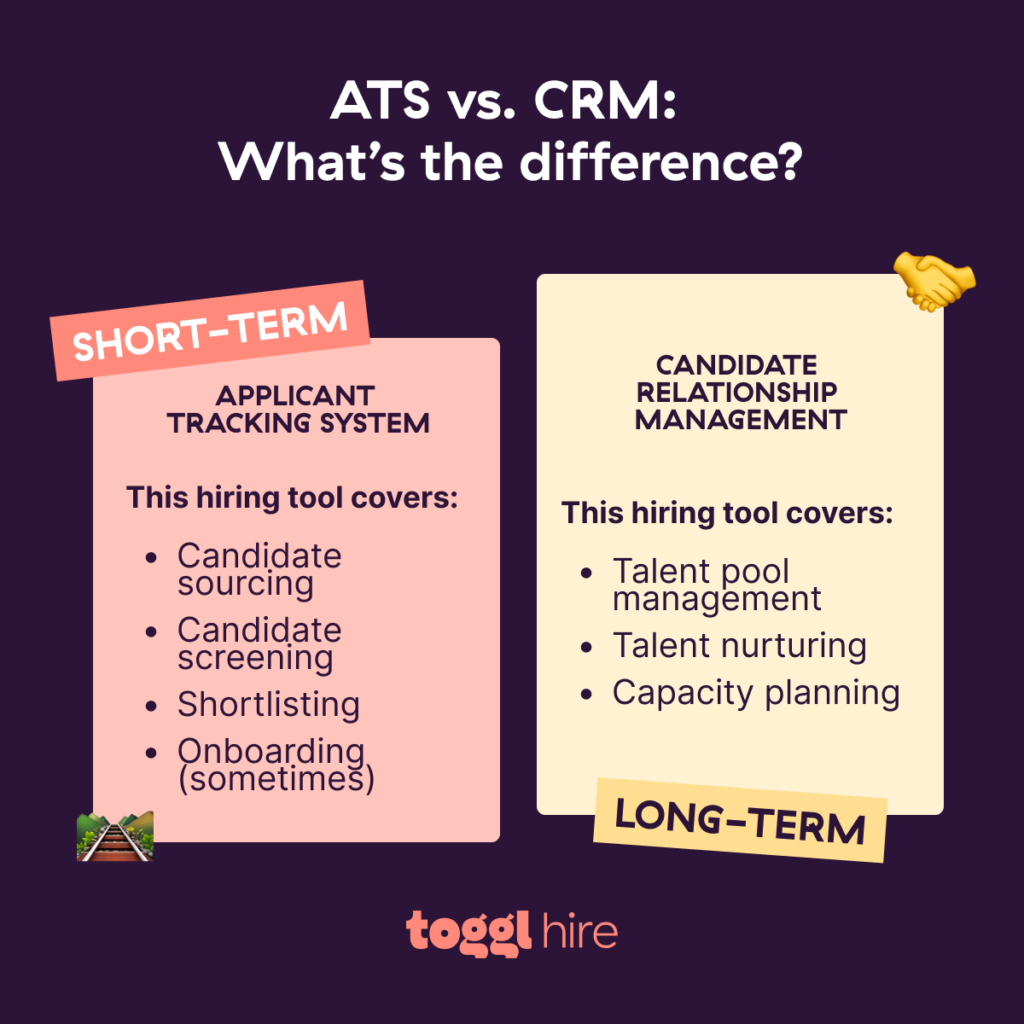
To choose the right candidate management system, consider its fit into your hiring process and value addition, like replacing manual interview scheduling or automating candidate status updates. Then, compare other factors like key features, scalability, and integrations.
Identify key features
CRM streamlines communication flows between your internal hiring teams, candidates, and third parties (e.g., a staffing agency).
All key information—candidate resume, contact details, qualifications, status, interview notes, skill assessment scores, and more—is visible to the recruitment team in one system.
From there, you can build custom candidate segments to grow your talent pool, track candidate status, and share feedback. Analytics dashboards provide insights into recruitment efforts and their outcomes.
Must-have features for candidate relationship management software
- Customizable hiring tracks
- Detailed candidate profiles
- Candidate-to-job matching
- Integrated communication tools
- Automated recruitment workflows
- Real-time reporting analytics
Consider scalability
The right software has to meet your hiring needs now and in the future. As your small business grows, hiring volumes and the average number of applicants per position skyrocket. At that point, you don’t want your candidate relationship management system to become useless due to limited storage.
A scalable CRM system lets you easily increase:
- The number of business users, applicants, and active job postings
- Storage space per user/organization to keep larger records
- Data retrieval speed for faster searches and report exports
- The number of integrations with other business software
Consider workflow limitations. Does the system allow advanced automation, process customizations, or user interface changes? Lack of wiggle room means you’d have to migrate to another platform eventually—incurring extra costs and troubles.
Evaluate integration capabilities
Companies use only 49% of paid SaaS apps, wasting thousands (if not millions) of dollars. Those apps are often redundant or don’t integrate well with existing software.
Don’t let your new CRM tool add to that sprawl. Check if it syncs with your team’s existing tools via native integrations, third-party low-code tools (e.g., Zapier), or a custom API that requires developer support.
In each case, pay attention to data synchronization. If the app creates redundant data copies, you’ll soon run out of storage. Delays in data sync with high data volume processing limit the records’ accuracy.
Can’t a recruitment agency handle your candidate relations?
In theory, yes. In practice, however, this may not be the best idea. Recruitment agencies have substantial talent networks and streamlined hiring pipelines. However, that expertise comes with a higher average cost-per-hire and a lack of control over candidate experience.
Investing in a CRM solution allows direct, on-brand interactions with applicants, data-rich candidate profile creation, and the adoption of new recruitment strategies like employee referrals, social media recruiting, or in-person events.
The best recruitment CRMs of 2025
To rate each CRM on our list, we consulted the Toggl Hire product team (obsessed with recruitment technology), pored through review websites, and spoke with professional recruiters.
The next seven products offer the finest blend of candidate experience management and applicant tracking features for full-cycle recruitment.
Zoho Recruit

Zoho Recruit supports talent teams at every stage of the recruitment process with convenient features for:
- Talent sourcing: Create career sites, and publish to multiple job boards and social media platforms.
- Applicant tracking: Maintain rich, searchable candidate profiles and streamline approvals and background screening.
- Candidate engagement: Automate candidate communication via a self-service portal and integrations with popular apps like Gmail, Outlook, and business SMS solutions.
Zoho Recruit simplifies capturing, storing, and sharing candidate information across the organization through intuitive workflow automation. The app also brings this information to applicants. Candidates can create personalized profiles, apply for multiple jobs, and receive automatic status updates with the Zoho Candidate Portal (costs $6/license per month).
Thanks to Zoho’s new Intelligent Assistant (ZIA), finding people with relevant skills is easy. ZIA interprets human language (beyond keyword-based resume parsing) to match talent pool candidates to the job opening and grade them accordingly.
If your recruitment marketing didn’t work this time, you’ve got more sourcing options. Zoho Recruit’s Vendor Portal allows you to invite staffing agency partners to submit candidates, and the Employee Referral feature enables anyone to recommend a good fit from their network and stay updated on their referral’s status.
That’s neat, as transparency and quick feedback are key to a successful employee referral program.
⚖️ Pros & Cons
| Pros | Cons |
| Easy-to-setup candidate portal for proactive expectation management | Steeper learning curve due to a variety of features |
| Easily share candidate data and statuses with hiring managers for faster coms | Candidate Portal and Video Interviews come at an extra cost monthly cost |
| Ability to add extra custom features with Developer Console | User data storage is limited to 1-3GB, depending on the plan. Additional storage fees kick in afterwards. |
💰Pricing
| Free Plan | Free Trial | Paid Plan |
| 1 active job | 15 days | From $25/user per month |
SmartCRM
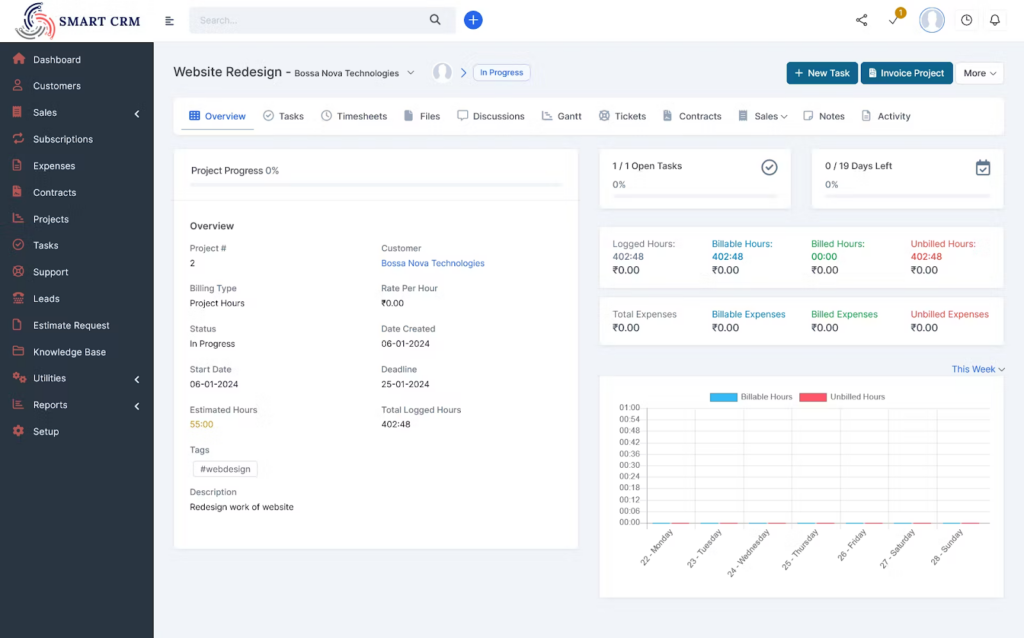
SmartCRM is a candidate relationship management module for Smart Recruiters software—a popular enterprise hiring platform. The three core features are:
- Talent pools: Keep previous applicants, internal candidates, leads, and employee referrals organized in one collaborative workspace.
- Rule-based automation: Apply filters and custom rules to curate candidate profiles and move them into your hiring workflows in the Smart Recruiters system.
- Email campaigns: Engage different talent segments with personalized email nurturing sequences. Design simple campaigns with a built-in email editor and track metrics like open rate, click-through rate, and bounce rate.
Beyond candidate experience management, Smart Recruiters’ platform offers modules for applicant tracking, job advertising, text recruiting, and a chatbot for collecting intake information and answering candidates’ FAQs.
⚖️ Pros & Cons
| Pros | Cons |
| Highly customizable to match your recruitment processes to a dot | Lack of transparency in pricing |
| Built with global recruitment compliance in mind | Long configuration process and steeper learning curve |
| Built-in tools for building email sequences for candidate engagement | Few integrations with other business tools are available out of the box. |
💰Pricing
| Free Plan | Free Trial | Paid Plans |
| Not available | Not available | Priced at a percentage of the core SmartRecruit ATS for unlimited user seats |
Toggl Hire
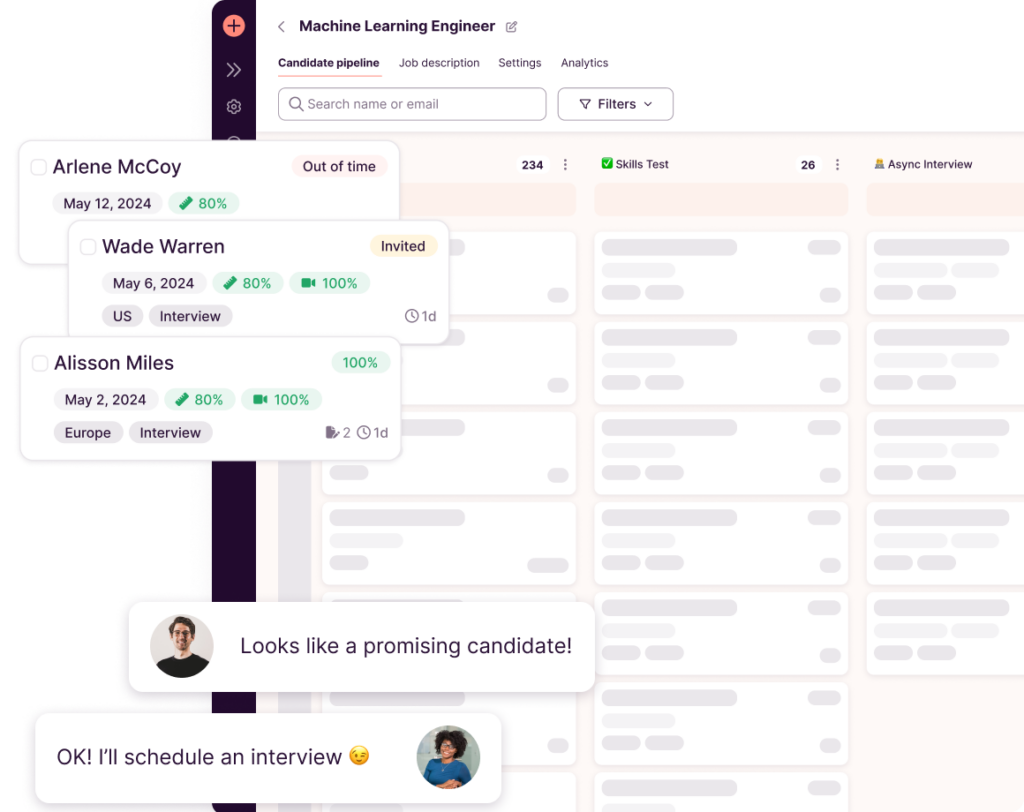
Toggl Hire is a full-cycle recruitment platform with native candidate management features (so you’re not paying extra!) Each plan offers unlimited jobs, skills, tests, and users—and access to the following features:
- Customizable application page to share your job description (we’ve got a battle-tested template!) and qualifying questions.
- Customizable hiring pipeline to match your recruitment flows and keep everyone in sync with collaborative candidate cards.
- Automatic polite candidate rejections based on qualifying questions or test scores, loads of email templates, and sleek email management tools.
- Full history of candidate communication flows to track each person’s progress in your hiring cycle.
- Trigger-based pipeline automation redirects successful candidates to the next step and sends reminders for incomplete tests or homework assignments.
We provide hiring teams of all sizes with ready-made hiring workflows and collaboration tools to funnel candidates through the pipeline based on their actual abilities, not self-reported accomplishments. By backing predictability and proactive communication into the process, Toggl Hire makes the hiring process transparent and delightful for candidates.
⚖️ Pros & Cons
| Pros | Cons |
| Premade hiring frameworks for streamlined, skills-based hiring | Doesn’t offer self-service candidate portals |
| Instant feedback via test results and automated email communication | Open-ended test question reviews require extra time from recruitment team |
| Candidate experience and feedback report for further improving your processes | Lacks native integration with popular interview scheduling tools |
💰Pricing
| Free Plan | Free Trial | Paid Plans |
| Covers unlimited jobs and 5 candidates | Most features are available on a free account | From $20/mo |
iCIMS
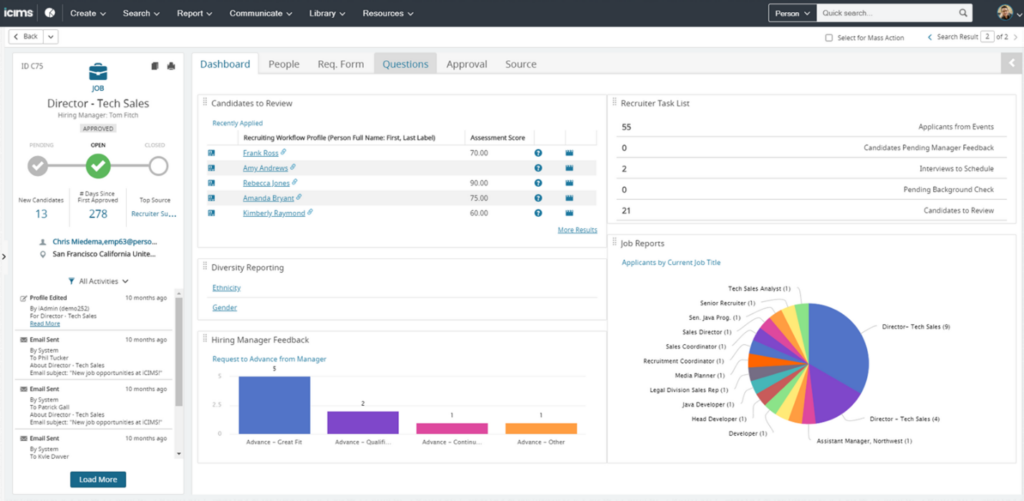
iCIMS Talent Cloud is another platform with loads of great recruitment and CRM features under the hood:
- Applicant tracking system (ATS)
- Automatic candidate matching
- Internal talent marketplace
- Career pathing
- Recruitment marketing tools
- Employee onboarding
For candidate relationship management, iCIMS has handy features like AI-driven candidate matching to job postings and sleek applicant remarketing.
You can nurture potential applicants with email campaigns, text messages, a digital chat assistant, and branded career sites. Video Studio lets you create low-lift employee testimonials for your talent acquisition campaigns.
The only major downside is most iCIMS software solutions must be purchased and configured separately—a lengthy process (up to a year!) according to current users.
⚖️ Pros & Cons
| Pros | Cons |
| Robust in processing a high volume of candidate applications from multiple hiring portals and job sites | Several workflows like Text Engagement and Offer Management don’t integrate well with ATS flow and require manual steps. |
| AI-powered digital assistant for sharing candidate updates, qualification screening, and interview scheduling | Requires an IT support assistant to properly configure, integrate, and customize the platform. |
| Features to plan, promote, and manage online and on-site recruitment events | Customer support is very hard to reach at times |
💰Pricing
| Free Plan | Free Trial | Paid Plans |
| Not available | Not available | Pricing on-demand |
Recruiterflow
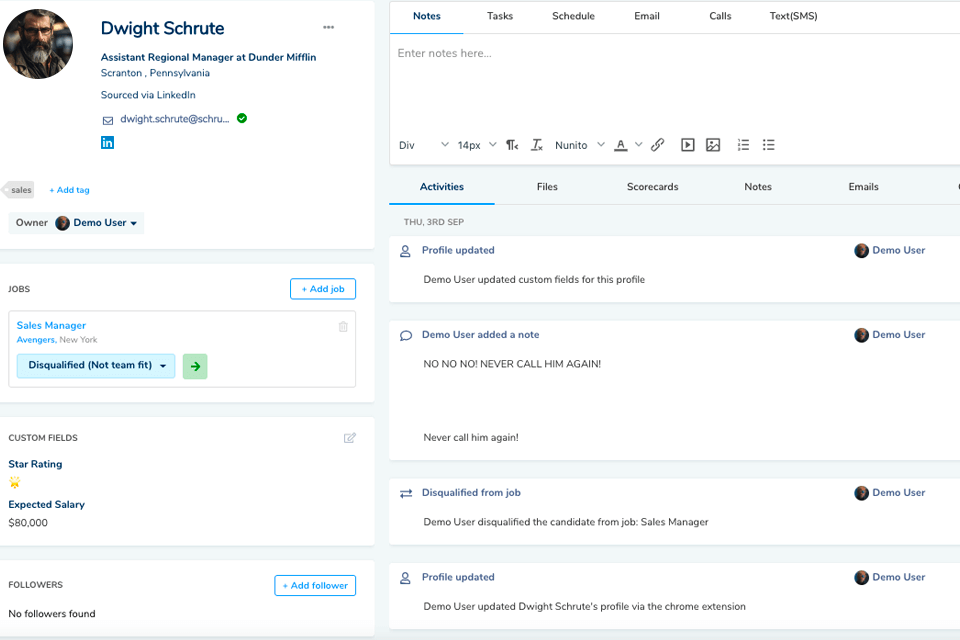
Recruiterflow is an ATS and CRM platform for recruitment agencies, boasting several great features for high-volume recruitment:
- Visual candidate pipelines with easy logging of all interactions across touchpoints (calls, texts, emails, phone interviews, etc.).
- Apply mass customization in your communication to engage candidates in open tracks and keep them vested in partnering with your agency.
- Client portal to present top talent to HR departments and collaborate on next steps.
- Chrome extension to capture prospects’ contact, social, and career details from the web.
Recruiterflow also offers customer relationship management functionality for recruitment firms, bearing the same CRM acronym as candidate relationship management. This suite of tools helps agencies keep better track of incoming service requests, open deals, and contract closing rates.
⚖️ Pros & Cons
| Pros | Cons |
| Visual Kanban-style workspace for large recruitment teams | No personal task dashboard available for tracking daily to-dos |
| Loads of ways to record, store, and share all candidate details at every stage of their application | Occasional glitches with automatic resume text recognition in PDF and Word |
| Trigger-based automatic communication for interview scheduling, disqualification, and other status updates | Offer management functionality is missing |
💰Pricing
| Free Plan | Free Trial | Paid Plans |
| Not available | 14 days | From $99/user per month |
Gem
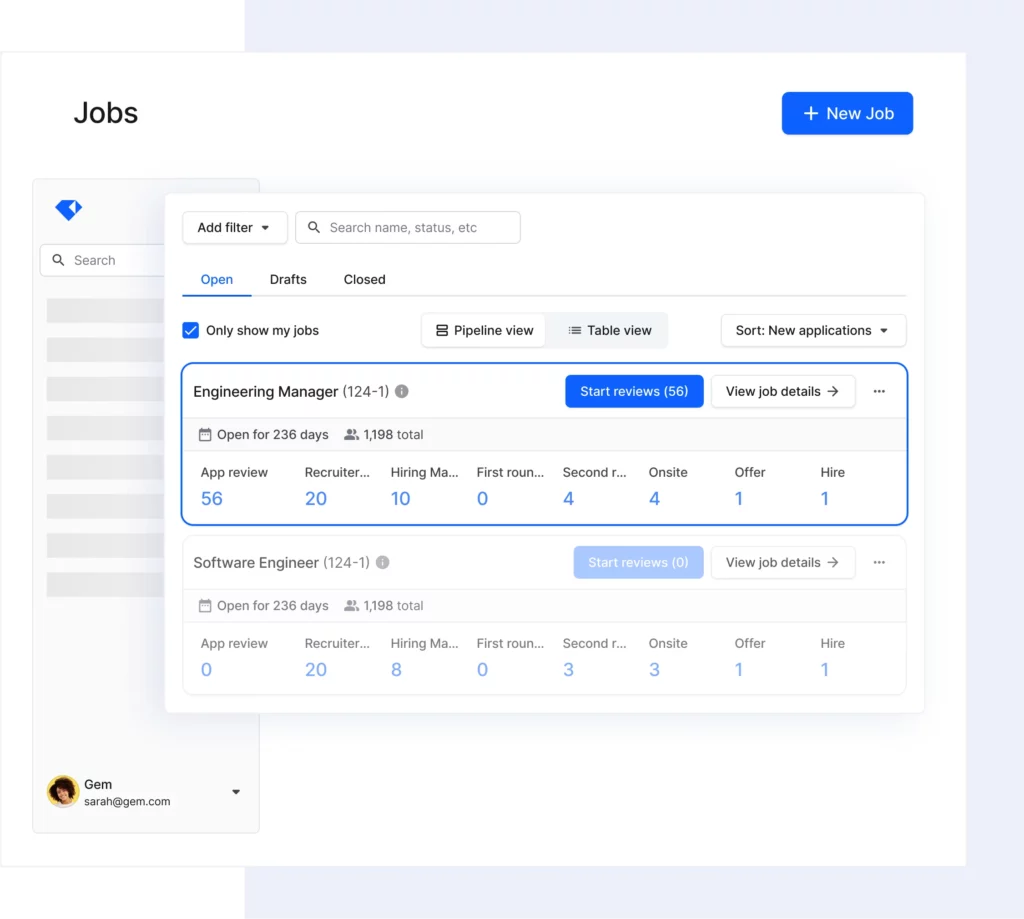
Gem has AI as its core selling point. Smart algorithms enable conversational candidate search in the ATS and CRM, candidate profile enrichment, and multi-stage personalized email sequence creation. AI-based candidate rankings are also coming soon.
Beyond that, Gem recruiting CRM:
- Builds candidate pools, based on job description, skills, location, and more
- Suggests qualified past candidates for open roles
- Creates candidate career path using LinkedIn data
- Visualizes all candidate touchpoints
- Automates interview scheduling even for edge cases
Gem’s analytics dashboards deserve a separate shoutout. You’ve got out-of-the-box templates and low-code tools to build custom reporting views. Through an end-to-end recruitment funnel visualization, you can identify bottlenecks to accelerate time-to-hire and improve candidate experience. Gem also supplies a proprietary benchmarking data set to benchmark your team’s performance against industry peers.
⚖️ Pros & Cons
| Pros | Cons |
| Continuous candidate data aggregation from multiple platforms for fresh insights | Automatic email detection doesn’t work well with candidates outside of the US |
| Built-in automation for interview event updates, alerts, interviewer swaps, and debriefs | Integrates mostly with other enterprise-grade ATS tools and popular sourcing sites |
| Advanced search through candidate profiles and candidate-job matching | Gem browser extension is only available for Chrome |
💰Pricing
| Free Plan | Free Trial | Paid Plans |
| Not available | Not available | Pricing on-demand |
Bullhorn

Bullhorn ATS/CRM platform caters primarily to staffing agencies with solid features for job order management, candidate search, and ongoing candidate engagement.
Key features include:
- Centralized system of record for all candidates, jobs, shifts, and team tasks
- Automatic email activity tracking for each candidate and real-time record updates
- Mass-mailing and in-platform messaging for candidate engagement
- Self-service experience for interview scheduling
- Candidate interaction analytics for different campaigns and touchpoints
On top of all that, Bullhorn offers detailed analytics. Each user gets a personalized dashboard with performance insights (e.g., new resumes sent, first interviews conducted, etc). Managers can build team reports to track employee productivity and benchmark performance against target metrics. The Jobs Pipeline dashboard provides real-time insights on live jobs, indicating which needs the most attention.
For larger organizations, Bullhorn also offers a Salesforce edition—a recruitment system built on the Salesforce platform.
⚖️ Pros & Cons
| Pros | Cons |
| Upload data from emails and create new tasks straight from your email inbox (Gmail or Outlook) | Slightly dated, clunky user-interfaces |
| AI-powered candidate matching to open jobs | Doesn’t allow to search candidates by their first name |
| GDPR and CCPA-compliant data collection and storage | Most customizations require a qualified vendor |
💰Pricing
| Free Plan | Free Trial | Paid Plans |
| Not available | Not available | Pricing on-demand |
How to best use recruitment CRM software to streamline hiring
A recruitment CRM is a tool (not a solution per se) that needs to be put to good use. To improve your hiring cycle and excel in candidate experience, you also need to adjust your processes.
Automate workflows
Recruitment automation eliminates time-consuming steps like manual data entry, spreadsheet sharing, or syncing interview notes. This frees recruiters to focus on what matters: finding and communicating with the right candidates.
With Toggl Hire, you can automate repetitive tasks like creating new hiring pipelines for new roles or follow-up emails for interviews and test task submissions. Recruitment CRMs also automate job posting distribution, candidate profile enrichment, status updates, email outreach campaigns, and more.
Leverage data analytics
CRM analytics helps you pinpoint hurdles in your hiring process and apply targeted interventions. No longer ponder if “it’s the candidate (or us) being ghosted” or “why hiring for one role takes over two months.” Analyzing candidate data reveals patterns in drop-off rates, prolonged hiring, and overlooked opportunities for accelerating passthrough.
For example, with Toggl Hire, you can see which recruitment channels drive the most applicants and attract the ones with the best skills to then double down on your efforts.
Maintain personalized communication
Nothing is more discouraging than a canned message saying “We’ll review your submission and be in touch”. It signals the candidate to apply elsewhere or accept a competing offer (if they have one).
Recruitment CRM tools help you share information about key hiring steps, automatically move successful applicants to the next stage, and share personalized status updates. Toggl Hire test takers receive an email showing their placement compared to other candidates, giving them a heads-up about their odds of passing to the next stage.
Remember 61% of applicants abandon a job application due to the lack of communication during the hiring process. Recruitment CRM tools allow you to send quick updates and more personalized email summaries, explaining the next steps.
Upgrade your applicant tracking system now
Talent acquisition and talent planning coexist. Integrating an applicant tracking system with a CRM merges these processes into one flow.
When the new job order arrives, you don’t have to start from square one. Instead, you can rekindle relationships with past applicants, pitch the offer to pre-qualified candidates from your talent pool, and delight the hiring manager with faster turn-around and better fits.
Candidates benefit too. Better data visibility and smart workflow automation mean greater transparency, faster replies, and a better interviewing experience.
With Toggl Hire, you can build customizable candidate pipelines, combining resume pre-screening, skills assessments, homework assignments, and interviews into one smooth hiring flow. You can customize the pipeline steps for each role and add test score-based triggers for automatic candidate progression with automatic email updates.
Hiring managers appreciate the extra clarity around candidate skills, while 80% of applicants love the efficiency of Toggl Hire experience.
Create a free account to see how Toggl Hire elevates the candidate experience.
Elena is a freelance writer, producing journalist-style content that doesn’t leave the reader asking “so what." From the future of work to the latest technology trends, she loves exploring new subjects to produce compelling and culturally relevant narratives for brands. In her corporate life, Elena successfully managed remote freelance teams and coached junior marketers.




